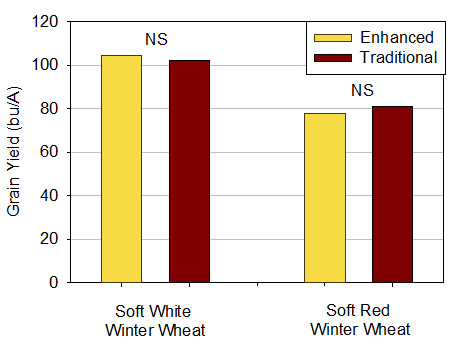Agronomic input considerations for Michigan winter wheat management
Will more inputs increase profits? A look at preliminary data.

Over the last several years, Michigan wheat growers have produced some of the greatest wheat yields in state history. Above average grain yields combined with continued demand from Michigan’s milling industry have led many wheat producers to consider applying additional agronomic inputs. As interest for intensive wheat management has increased, two questions are often asked: 1) Does the increased use of inputs increase yield, or more importantly profitability? And 2) if yes, then which specific inputs are most important?
In an attempt to better answer these questions, multi-year research trials were established in Lansing, Michigan, on soft red winter wheat (‘Sunburst’) and Richville, Michigan, on soft white winter wheat (‘Jupiter’) to compare six agronomic inputs commonly used in Michigan wheat production: urease inhibitor, nitrification inhibitor, plant growth regulator, foliar micronutrients, fungicide and increased rates of nitrogen (N) fertilizer.
Inputs were compared by utilizing an omission trial design. To better understand wheat response to the removal of individual inputs, grain yield differences were examined between wheat that received all six inputs (i.e., enhanced) as compared to wheat that had each individual input removed one at a time. Agronomic inputs were also evaluated utilizing the reverse approach by comparing grain yield differences between wheat that had no additional inputs except for a base rate of N fertilizer (i.e., traditional) as compared to wheat that had each individual input applied one at a time. The base rate of N fertilizer was 90 lbs. per acre for soft red wheat in Lansing and 120 lbs. per acre for soft white in Richville. The high N component consisted of a 20% increase in total N rate (108 lbs. per acre in Lansing and 144 lbs. per acre in Richville).
Removal of the +20% N treatment from the enhanced system resulted in the greatest yield decline of 8.4 and 14.5 bushels (bu) per acre in Lansing and Richville, respectively. Yield decreases from the removal of the increased N rate also corresponded to the greatest gross profit losses across both locations. Removal of the foliar micronutrients from the enhanced system resulted in a yield increase of 9.8 bu. per acre at the Lansing location only, which also produced a significant gross profit increase. An antagonistic interaction may have occurred from combining the foliar micronutrient (which contained an adjuvant) and the plant growth regulator as plant height was further reduced where both were applied as compared to the growth regulator individually. Yield increased nearly 11 bu per acre at the Lansing location when the fungicide, applied at flowering, was added to the traditional system. Significant foliar disease pressure was only present at the Lansing location suggesting a positive yield response to fungicide application in the presence of disease.
Figure 1. Enhanced (containing all 6 inputs) as compared to traditional (no additional inputs other than base N rate) management of soft white and soft red winter wheat during the 2016 growing season in Richville and Lansing, MI.

The 2016 growing season demonstrated an overall lack of input response across both locations and varieties in these respective studies. Enhanced as compared to traditional wheat management produced 105 and 102 bu. per acre for soft white and 78 and 81 bu. per acre for soft red wheat, respectively (see Figure 1). A lack of N loss conditions, minimal plant lodging, and no micronutrient deficiencies across either location suggest that a grain yield response from these inputs should not have been expected. In this particular study, first-year preliminary data suggest that high-input wheat management did not increase yield or profitability. Producers should look to incorporate the use of individual agronomic inputs based on environmentally vulnerable production regions and plant variety characteristics rather than applying a suite of inputs as insurance against adverse growing conditions. Studies will continue in 2017 and these results as well as other soil fertility and nutrient management field study results are available at soil.msu.edu.
Dr. Steinke’s work is funded in part by MSU’s AgBioResearch.



 Print
Print Email
Email